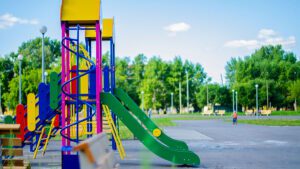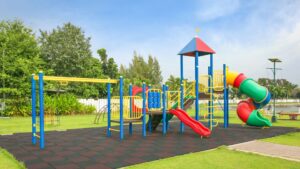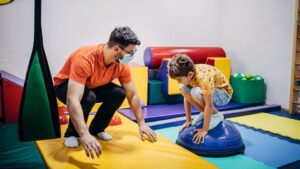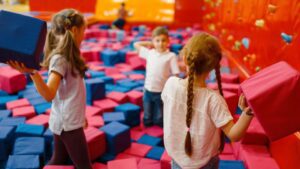Я преподаватель по оценке сенсорной интеграции, и каждый год я оцениваю сенсорную интеграцию более 100 детей. Большинство из этих детей страдают такими нарушениями развития, как аутизм, церебральный паралич, умственная отсталость, языковые нарушения, СДВГ и задержка развития. У многих из них наблюдаются симптомы дисфункции сенсорной интеграции.
Однако большинство типично развивающихся детей не испытывают дисфункции сенсорной интеграции. Если кто-то утверждает, что у вашего ребенка проблемы с сенсорной интеграцией после нескольких занятий, его главной целью может быть продажа вам своих обучающих программ.

Что такое сенсорная интеграция?
Сенсорная интеграция - это понятие, введенное доктором Айресом из Калифорнийского университета в 1972 году. Он разделил органы чувств на семь типов: зрительные, слуховые, обонятельные, вкусовые, тактильные, вестибулярные и проприоцептивные. Сенсорная интеграция - это то, как мы обрабатываем сенсорную информацию и реагируем на нее соответствующим образом.
Например, если вы видите летящий в вашу сторону мяч, ваш мозг обрабатывает эту визуальную информацию, и ваше тело реагирует, чтобы избежать удара. Этот процесс восприятия и реагирования на внешние раздражители и есть сенсорная интеграция.
Дисфункция сенсорной интеграции включает в себя:
- Проблемы с сенсорным вводом (например, не может видеть мяч)
- Вопросы обработки (например, видеть мяч, но не знать, что делать)
- Проблемы с сенсорным выходом (например, знать, что мяч приближается, но быть слишком медленным или неуклюжим, чтобы избежать его)
У типично развивающихся детей дисфункция сенсорной интеграции встречается редко, но у детей с нарушениями развития - часто. Например:
- У детей с СДВГ часто возникают проблемы с вниманием, и они могут не заметить приближающийся мяч.
- Дети с аутизмом могут видеть мяч, но не знать, как на него реагировать.
- Дети с церебральным параличом или умственной отсталостью могут понимать, что мяч приближается, но им не хватает координации, чтобы избежать его.
Как сенсорная интеграция связана с когнитивным развитием?
Сенсорная интеграция играет важнейшую роль в когнитивном развитии, формируя основу детского интеллекта. Теория когнитивного развития Жана Пиаже подразделяется на четыре стадии:
- Сенсоримоторная стадия (0-2 года): Развитие от внешнего поведения к внутренним психическим характеристикам.
- Дооперациональная стадия (2-7 лет): Стадия использования символического мышления, языка и образной игры.
- Стадия эксплуатации бетона (7-11 лет): Развитие логического мышления и решения задач с помощью конкретных предметов.
- Формальный этап работы (11 лет и старше): Способность к абстрактному мышлению.
Теория Пиаже показывает, что дети воспринимают мир иначе, чем взрослые. Например, до 1 года младенцы не обладают самосознанием и не могут связать впечатления во времени. Понимание ребенком постоянства объектов (идея о том, что объекты продолжают существовать, даже если их не видно) развивается по мере развития сенсорно-моторных навыков.
Как сенсорная интеграция влияет на повседневную жизнь детей?
Дисфункция сенсорной интеграции может повлиять на различные аспекты жизни ребенка:
- Навыки самообслуживания: Дети могут испытывать трудности при выполнении таких задач, как одевание, кормление или избегание несчастных случаев.
- Обучение и внимание: Дети могут испытывать трудности с тем, чтобы усидеть на месте, сосредоточиться, читать, писать или четко говорить.
- Социальное взаимодействие и эмоции: Дети могут испытывать трудности с управлением своими эмоциями, общением или иметь низкую самооценку.
Виды дисфункции сенсорной интеграции:
- Дисфункция сенсорных реакций
- Избыточная чувствительность вестибулярного аппарата: Боязнь высоты, вращающихся предметов, громких звуков или яркого света.
- Пониженная чувствительность вестибулярного аппарата: Трудности с восприятием движения или звука, приводящие к проблемам с равновесием.
- Вестибулярные поиски: Заниматься повторяющимися движениями, такими как вращение, бег или самобичевание.
- Проприоцептивная дисфункция
- Низкая проприоцептивная реакция: Ребенок не знает о положении тела, что приводит к медленным или неуклюжим движениям.
- Проприоцептивные поиски: Дети могут стремиться к постоянному физическому контакту, например, врезаться в предметы, грызть игрушки или намеренно падать.
- Тактильная дисфункция
- Тактильная сверхчувствительность: Ребенок может сопротивляться физическому контакту или бояться определенных текстур (например, одежды или еды).
- Тактильная неполная чувствительность: Ребенок может не чувствовать боли или прикосновений и игнорировать физический дискомфорт.
- Тактильные поиски: Ребенок может чрезмерно трогать предметы или класть их в рот для получения сенсорной обратной связи.

Может ли тренировка сенсорной интеграции принести пользу типично развивающимся детям?
Полезны ли занятия по сенсорной интеграции для типично развивающихся детей?
Да, тренинг сенсорной интеграции может принести пользу всем детям. Она предназначена не только для детей с нарушениями, но и помогает им развивать способность исследовать и понимать окружающий мир. Сенсорная интеграция - это фундамент для обучения, помогающий детям совершенствовать координацию, равновесие и внимание.
Характеристики терапии сенсорной интеграции:
- Под руководством детей: Ребенок берет на себя ведущую роль в деятельности.
- Поощрение самостоятельного обучения: Ребенок исследует и учится на собственном опыте.
- Веселый и гибкий: В терапии используются увлекательные игры, чтобы заинтересовать детей.
- Мотивация: Занятия задействуют внутренний драйв и любопытство ребенка.
- Адаптируемый: Занятия разработаны с учетом индивидуальных потребностей ребенка.
Будьте осторожны при выборе программ сенсорной интеграции
На рынке полно программ сенсорной интеграции, и не все они легальны. Я бы посоветовала родителям типично развивающихся детей быть осторожными при выборе программ, поскольку многие из них созданы для того, чтобы продать больше услуг. Если вы заинтересовались сенсорной интеграцией, возможно, вам захочется узнать об этих методиках самостоятельно. Сенсорная интеграция также может быть реализована в виде серии приятных занятий для родителей и детей дома.

Ключевые моменты, о которых следует помнить
- Сенсорная интеграция помогает детям обрабатывать сенсорную информацию и правильно реагировать на нее.
- Он особенно полезен для детей с нарушениями развития, такими как аутизм, СДВГ и церебральный паралич.
- Даже типично развивающиеся дети могут извлечь пользу из тренировок по сенсорной интеграции, поскольку они способствуют общему развитию и когнитивному росту.
- Терапия сенсорной интеграции должна быть под руководством детейВесело, с удовольствием и с учетом индивидуальных потребностей.




